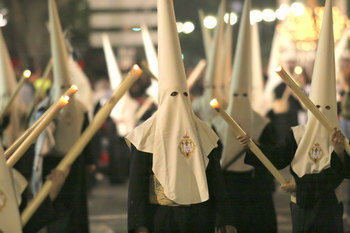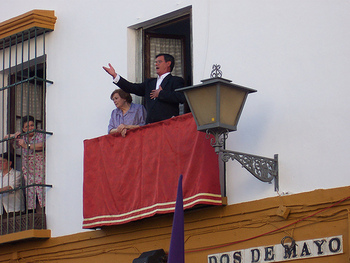Spain is very famous for numerous events held during Semana Santa or Holy Week. Holy Week (Hebdomada Sancta or Maior Hebdomada – „Greater Week“) in Christianity is the last week before Easter. It includes religious holidays of Palm Sunday, Maundy Thursday (Holy Thursday) and Good Friday. I does not include Easter Sunday which belongs to The Great Fifty Days.
All of the religious holidays mentioned commemorate the last week in life of Jesus Christ, his crucifixion on Good Friday and the resurrection on Easter Sunday.
Processions in Spanish cities are especially spectacular. Some of the people participating in procession wear the nazareno or the penitential robe. It has several parts – a tunic, „capriote“ (a conical shaped hood) used to hide the face of person wearing the nazareno. Sometimes person also wears a cloak too. The nazareno robe is of medieval origin.

Nazarenos in Malaga
People wearing such robe or „nazarenos“ during procession carry candles or wooden crosses. In some situations they walk barefoot with shackles and chains on their feet as sort of penance.
Beside the nazarenos some people in Spanish processions wear the uniforms similar to those worn by soldiers in Ancient Rome.
Traditions of Holy Week in southern Spanish city of Malaga have history of over 500 years. Processions are organized throughout the Holy Week but certainly the most spectacular ones are those on Maundy Thursday and Good Friday.

Semana Santa in Malaga
Element typical for this, and all other Spanish processions, is so called „trono“ or throne (float). What exactly is it? It is kind of platform with many ornaments, often very heavy (even more than 5000 kilograms), on which paintings or sculptures with scenes from the Passion are carried. The Passion in this sense means the suffering of Christ before and during the Crucifixion.
Tronos in Malaga are carried by more than 250 members of the brotherhood of Nuestra Señora de la Esperanza. Walking behind the nazarenos wearing purple robe are women in black carrying candles.
The procession is accompanied by emotional music (played with drums and trumpets) and singing of “saeta” dedicated to the float. The saeta is a very old traditional Spanish religious song. The Spanish word saeta has differnt meanings -“arrow“, "bud of a vine", "hand of a clock" or "magnetic needle". Since the 19th century saetas includes elements of flamenco. The Saeta is sung by the saetero. During the procession saetero usually sings from one of balconies along the road.

Saetero
Thousands of people gather and watch the procession. They often applaud their famous brotherhoods. These applauds and flamenco type of song during the event which is essentially sad make the procession very special, a bit unusual when compared to others in Spain. It does not mean that people of Andalucia are less religious. They just show their faith in a different way.

Nazarenos in Seville
For the next of famous Spanish processions we’ll stay in Anadalucia. The procession during Semana Santa in city of Seville is famous for “pasos”. Pasos are big painted wooden sculptures. Each one of them represents scenes in the last days of Jesus Christ and immense grief of Virgin Mary for the torture and killing of her son.

Paso in Seville
Pasos are quite heavy so they are carried by “costaleros” or “sack men”. They are called so as they have special headdress. Each paso is carried by 24 to 48 people. They are hidden inside the paso, so it seems that it walks by itself.

Costaleros ("Sack men")
The next of Spanish cities famous for its processions is the city of León (Llión in Leonese language), located in the province of same name in the north of Spain. Processions in this city last from the Friday before the Santa Semana (“Viernes de Dolores”) until the Easter Sunday.
More than 15,000 people or “papones" in Leonese language participate in processions. The most famous of local processions is the one called the "Procesion de los Pasos" or the "Procesion del Encuentro" (Procession of the Meeting). It lasts for nine hours. During this procession some 4,000 people carry 13 "pasos" throughout the city.

Procesion de los Pasos in Leon
The most impressive moment of the procession is certainly El Encuentro (The Meeting). Then two pasos – representing Saint John and “La Dolorosa” (Virgin Mary) – face each other. Carriers of passos move them so local people say that they are “dancing” (“bailados”).

Entierro de San Genarín
León also has the civilian procession called Entierro de San Genarín, the "Burial of Saint Genarín". There is a story behind it. In 1929, on the night of Maundy Thursday, poor alcoholic Genaro Blanco was run over by the first garbage truck of the city. In front of this procession some Orujo is carried.
Orujo is a liquor (with an alcohol content of over 50%) made of the grape pomace (remains left after pressing of grapes during wine making). At the place of tragedy some cheese, a bottle of Orujo and two oranges are left in commemoration.
Cartagena is a city in Spanish Murcia region located in the southeast of the country. Local processions during Santa Semana are organized by four brotherhoods - The penitential brotherhood of the Most Holy (wearing black), The brotherhood of the Hour of Our Lord Jesus´ Arrest or “Californios” (wearing red) , The brotherhood of Our Lord Jesus of Nazareth or “Marrajos” (wearing purple) and The brotherhood of Our Lord Jesus Resurrected or “Resucitados” (wearing white).
During procession brotherhoods are divided into small groups called “agrupationes”. Each group carries one float made of carved and painted wood. Members of one group wear the clothes of same colour (the robe, sash around the waist, a cloak, a high pointed hood covering their heads and faces) and sandals.

Semana Santa in Cartagena
In front of the float there are three people carrying the brotherhood flag (“estandarte”) and several others standing in two symmetrical lines. All participants walk and stop in the rhythm of drum played by the band walking behind them. When the drumming stops everyone stands still in absolute silence. Everything has sort of a nickname – “tercio” or “regiment”.
A bit about floats in the procession. Paintings on them were made by famous local artists - Francisco Salzillo, José Capuz, Juan González Moreno, Mariano Benlliure, Federico Coullaut-Valera and others. During the procession they are set in order of events presented in the Gospel. Paintings are surrounded by “cartelas” (candelabras or chandeliers) decorated with floral arrangements.
At the back of main procession there are infantry companies or “piquetes”. They accompany the float of Our Lady of Sorrow or Our Lady of Solitude.
Many more Spanish cities and towns have beautiful procession of Santa Semana. But let’s finish this article in Andalucia with processions in city of Linares. Processions there last from the Palm Sunday until Easter Sunday. In the night between Holy Thursday and Good people or Linares organize the most famous procession called "Procesión del Nazareno".

Procesión del Nazareno in Linares
The procession includes many “pasos” (wooden sculptures). The most beautiful is the group of pasos representing the scene of Last Supper of Christ and his 12 Apostles.
In front of every procession in Linares there is a music band called “Banda de Cabecera”. They are performing songs from films, famous pieces of classical music and even pop music.
From Traditionscustoms.com


No hay comentarios:
Publicar un comentario